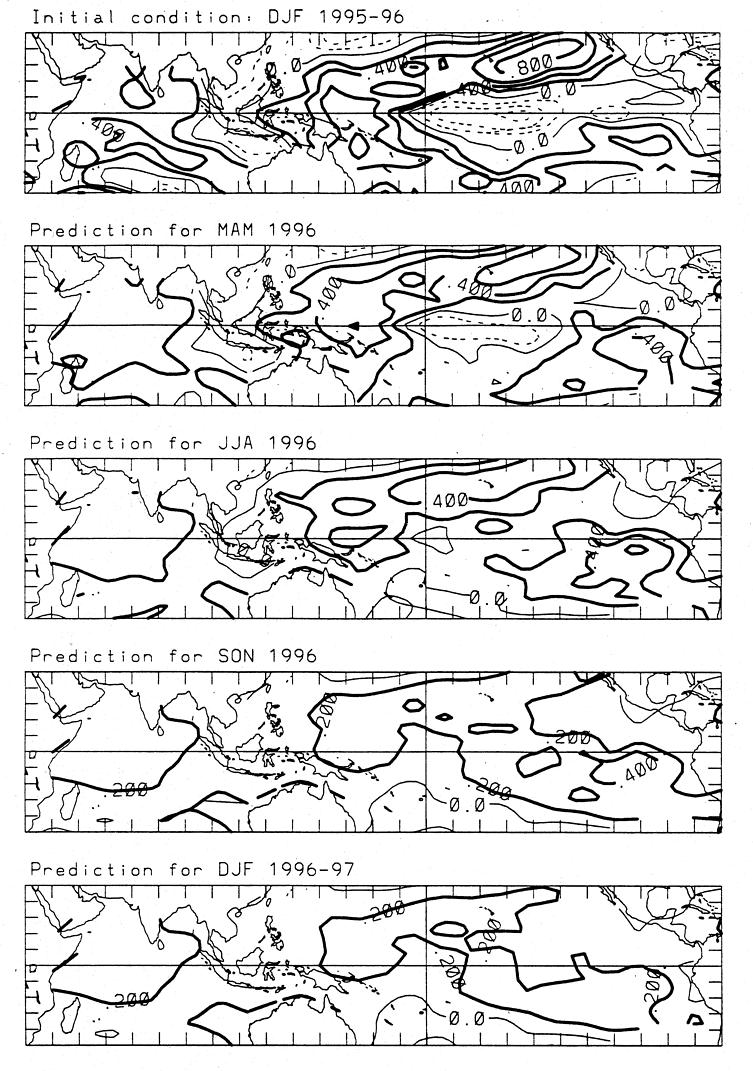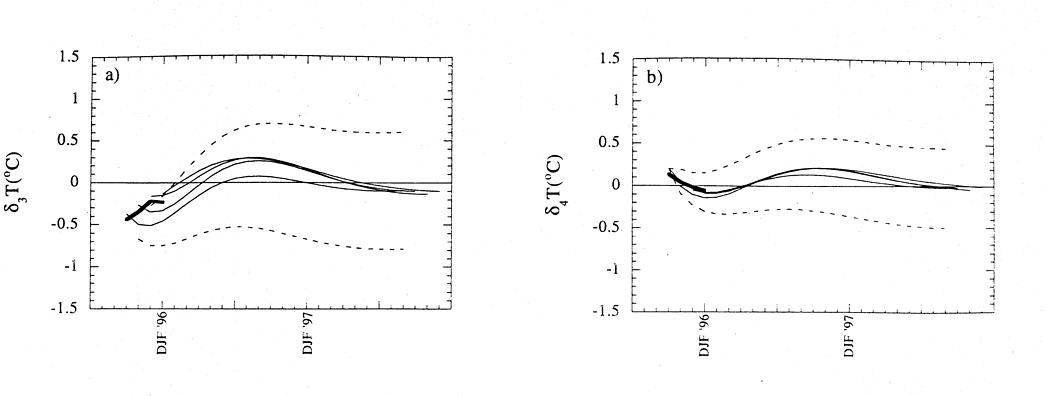[Next Article] -
[Previous Article]
Forecast of Pacific-Indian Ocean SSTs Using Linear
Inverse Modeling
contributed by Cecile Penland1, Klaus Weickmann2 and Catherine Smith1
1CIRES, University of Colorado, Boulder, Colorado
2Climate Diagnostics Center (CDC), ERL/NOAA, Boulder, Colorado
Using the methods described in Penland and
Magorian (1993) and in previous issues of this Bulletin
(particularly the December 1992 and June 1993 issues),
the sea surface temperature (SST) anomaly in the Niño
3 region (6oN-6oS, 90o-150oW), as well as the anomaly
in the Niño 4 region (6oN-6oS, 150 oW-160 oE), are
predicted. A prediction at lead time t is made by
applying a statistically-obtained Green function G(t) to
an observed initial condition consisting of SST
anomalies (SSTAs) in the IndoPacific basin. Three-month running means of the temperature anomalies are
used, the seasonal cycle has been removed, and the data
have been projected onto the 20 leading empirical
orthogonal functions (EOFs) explaining 73% of the
variance. The Niño 3 region has an RMS temperature
anomaly of about 0.7oC; the inverse modeling
prediction method has an RMS error of about 0.5oC at
a lead time of nine months and approaches the RMS
value at lead times of 18 months to two years. The
COADS 1950-79 climatological annual cycle has been
removed.
The predicted IndoPacific SSTA patterns based on
the Dec-Jan-Feb 1995-96 initial condition for the
following Mar-Apr-May, Jun-Jul-Aug, and Sep-Oct-Nov 1996, and Dec-Jan-Feb 1996-97, are shown in Fig.
1 (contour interval is 0.2oC). Figure 2a shows the
predictions (light solid lines) and verifications (heavy
solid lines) of the Niño 3 anomaly for initial conditions
Sep-Oct-Nov and Oct-Nov-Dec 1995, and Nov-Dec-Jan
and Dec-Jan-Feb 1995-96. The 1-standard deviation
expected error for the prediction based on the Sep-Oct-Nov 1995 initial condition is denoted by dashed lines.
Figure 2b is the same, but for the Niño 4 region.
Verification and prediction do not exactly coincide at
zero lead time since SSTAs are projected onto 20 EOFs
for the prediction and the truncation error is included in
the verification.
Consistent with the forecast published in the
December 1995 issue of the Bulletin, this prediction
calls for a decay of cold anomalies in the next few
months. Warm anomalies are predicted to grow in the
southeastern tropical Pacific and extend northward. The
rapid decay of the predicted anomalies at lead times
greater than six months is an indication of the
uncertainty of the prediction at those lead times given
current initial conditions.
References
Penland, C. and T. Magorian, 1993: Prediction of
Niño 3 sea-surface temperatures using linear inverse-
modeling. J. Climate, 6, 1067-1076.
Figures

Figure 1. Linear inverse modeling
forecasts of SST anomalies, relative to the standard 1950-79 COADS
climatology both for the training period (1950-84) and for these
forecasts. Forecast anomalies are projected onto 20 leading EOFs,
based on Dec-Jan-Feb 1995-96 initial conditions (top panel). Contour
interval is 0.2oC. Positive anomalies are represented by heavy solid
lines, negative anomalies by dashed lines. SST anomaly data have been
provided by NCEP, courtesy of R.W. Reynolds. Prediction by linear
inverse modeling is described in Penland and Magorian (1993).

Figure 2. (a): Prediction
(light solid lines) and verification (heavy solid line) of the Ni¤o
3 SSTA based on initial conditions Sep-Oct-Nov and Oct-Nov-Dec 1995,
and Nov-Dec-Jan and Dec-Jan-Feb 1995-96. Dashed lines denote one
standard deviation prediction error bars appropriate to a stable linear
system driven by stochastic forcing for the Sep-Oct-Nov 1995 initial
condition. Verification and prediction do not exactly coincide at zero
lead time since SSTAs are projected onto 20 EOFs for the prediction
and the truncation error is included in the verification. (b): As in
(a) except for Ni¤o 4.
[Purpose] -
[Contents] -
[Editorial Policy] -
[Next Article] -
[Previous Article]

